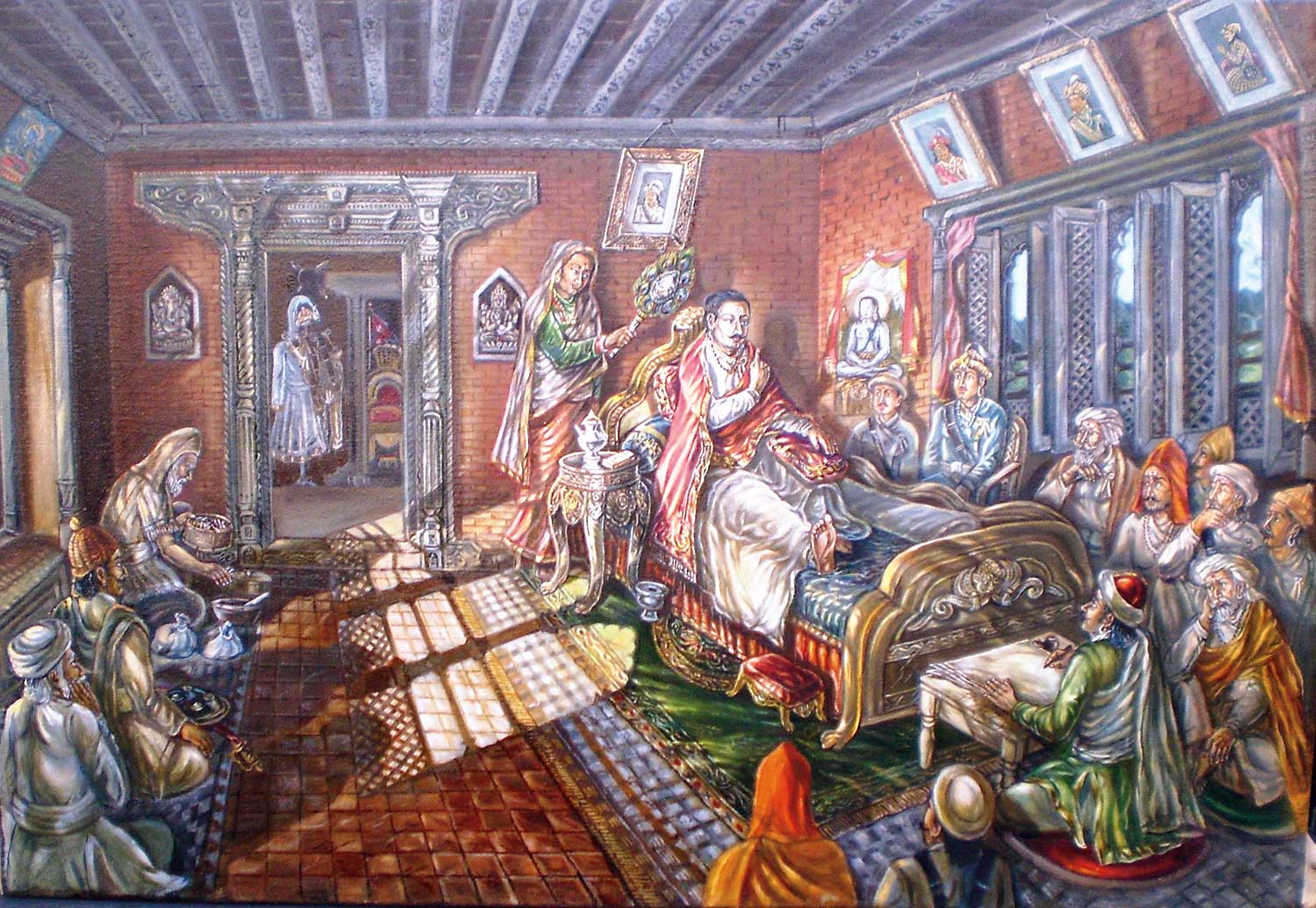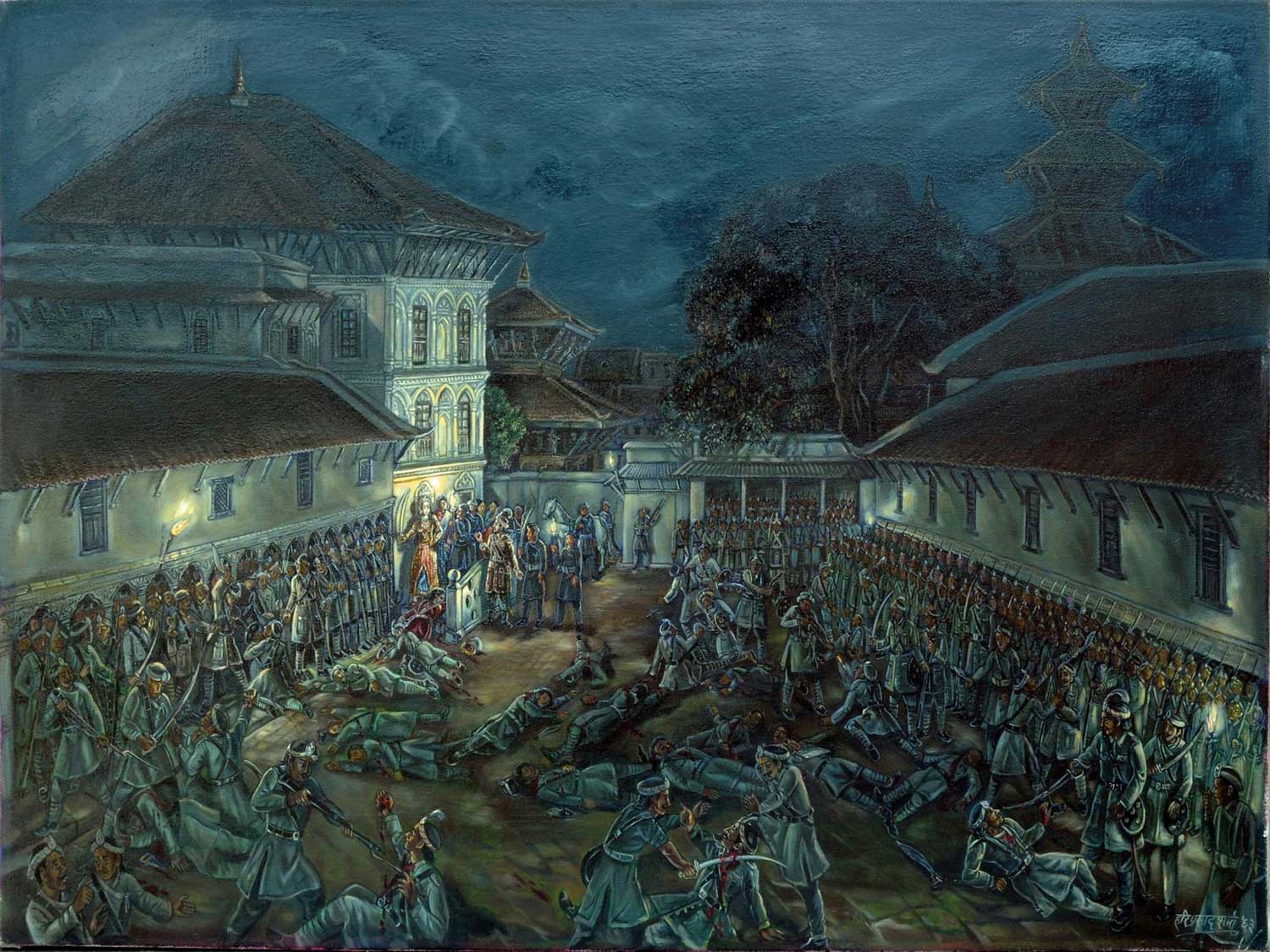
When we talk about works of art, they are usually self-expressions or statement made by the artist. As for the works of Hari Prasad Sharma, what I’ve observed is that they have a flavor of both. They are self-expressions in the sense of their content. They serve as visual narratives to the many events of the history of Nepal in their traditional architectural and cultural settings. These visuals are not random interpretations made by the artist but well researched by visiting sites, reading texts, recollecting memories and even getting help from Google Maps. They are then composed on the canvas, by the artist as per the environment of the times. The statements put forward are the visual documentation of recorded historical events.
When we look deeper into the paintings of Sharma, what we notice are symmetrical, yet complex compositions. Symmetrical because it is easy to divide the compositions into mostly vertical halves and complex because the artist takes special care not to omit any props that are required to complete the historical context. For example in the painting of the Dibya Upadesh of Prithivi Narayan Shah, when the king is advising his courtiers about polity, small details in the interior of the palace are carefully thought of; the play of light and shade, the props and people that surround the king, including the view of the hills outside the window, dramatize the event, which in fact is a very significant one in our history.
The repeated use of lines leads the viewer’s eyes around the canvas, and in the paintings of Sharma, the lines converging, most often in the center of the compositions, serve to add space and a three-dimensional feel. The dramatic use of light and shade, or the technique of chiaroscuro, which results in well-defined shadows, adds strong contrast which also serves to add volume and depth to the paintings. The artist is very careful to show a single source of light, from outside the image in daylit scenes, and the night scenes are illuminated mostly with oil wick lamps within the composition. This creates a unity in the fall of the shadow, adding a balance to the compositions and providing an illusion of wider space. The natural colors of reality are well presented in his paintings, representing the real world. Therefore, most of the paintings depict a panoply of colors, in their true settings.

The main theme of the artworks themselves seldom need interpretation, as they represent a visual narrative of historical events of the past, however it is important to read the symbols used by the artist to depict the various eras when the events took place. The use of these symbols are the result of the different types of research that Sharma undertakes to visualize these narratives. Since his paintings are of periods that neither he, you nor I have witnessed, nor do we have photographic documentation of most, he takes the aid of literary sources and of existing heritage and architectural settings around us to make the connection and complete the context. It is a challenge to depict the old in a time of constantly changing landscape.
Sharma is assisted by his son, Bishnu Prasad Sharma, who despite having a busy schedule as an associate professor, finds time to take his father out to sites significant for his compositions, take pictures as references, make literature available to his father and also does extensive online research to add to the accuracy of space and time in the compositions—besides daily discussions about the progress of the paintings. Together they work as a duo of director and producer, making this artistic journey very progressive and procreative.
Sharma studied art from the age of 8 or 9 under the artist Jeev Ratna Shakya. At the age of 11 he enrolled in Juddha Kala Pathshala in the year 2005 BS. After 5 years he graduated receiving the Kala Kaushal (a degree of that time). His childhood interest in art was discouraged by his grandfather who thought art to belong to the Chitrakar community and that Brahmins were meant to study the Vedas. Despite this discouragement, he did not stop, and made the small drawings of naags and that of Lakshmi, used during Naag Panchami and Lakshmi Puja, which were promoted by his father at the houses of Ranas and other aristocrats. The small rewards earned from these drawings acted as motivation to continue his artistic journey. An inborn artist, he was quick to learn and his passion led him to carry a notebook and pencil around so he could quickly sketch whatever he liked and whenever he wanted to. Unaware of western schools or any other styles of art, he copied images of deities, drew what he saw and developed his skills.
Born in typical Newar surrounding at Gophal Tole, Lagan, Kathmandu, he grew up witnessing the various festivals celebrated by the Newar community and is a fluent Newari speaker as well. Thus from a young age he had special interest in cultural heritage. His curiosity for small details and observant nature and the ability to make mental notes were to become his fortes. It was only years later, after visiting an exhibition of paintings made by Henry Oldfield (who served as the doctor in the British Residency 1850-63 AD) at the Baggikhana (now the Yala Maya Kendra) at Patan in 2052-53 BS, with his son, that he realized the value of paintings that represent the past. Taking inspiration from this exhibition, along with motivation from his son to make paintings of historical events of Nepal, he thus started a new chapter of his life.
He has since painted many such events: Dibya Upadesh by Prithivi Narayan Shah, Victory of Prithivi Narayan Shah over Kathmandu Valley, King Jai Prakesh Malla , Siddartha ko grihatyag, Jung Bahadur with Laura Bell in England, Emperor Ashok at Lumbini, to name just a few. He paints realistic scenes of historical events and the cultural life of the past, without distorting the forms or colors. What sets his paintings apart are the consistency in style, realistic forms, heightened use of light and shade, the use of a converging point to add a sense of depth and perspective to the composition and his ability to transform a 2D canvas into a 3D composition. Because of this his artwork is able to make the viewer feel and experience the subject, arousing emotions and thus creating a direct contact with the viewer, whose attention is caught by the little details that we often miss out when reading about the same subject.
Sharma says that “to create something of value and make a contribution to society,” is the purpose of his paintings. Rightfully expressed, his artworks serve to document the human history of our country as well as express collective memory. They seek to express to people important values within society, in a way that makes it memorable as well as reinforces values by commemorating great events. From the very beginning of existence, art has played a crucial role to record and preserve human history and so will the artworks of Sharma. At his present age of 83, he has the same zeal and enthusiasm to create more art that he had in his midlife. Which is evident from the fact that he is unable to make a proper signature on any official document, however on the canvas, his brush strokes flow without any inhibition.

His recent exhibition ‘Art through the Ages’ at Nepal Art Council (September 6-26, 2019) presented 45 paintings created during his lifetime. The display in the ground floor held an array of paintings composed in cultural settings of medieval Kathmandu, highlighting the Newar community in their daily lifestyle. The upper floor showcased the narrative of numerous historical events that occurred before the invention of the camera. The events of the past can be recorded only in two forms: the visual and the literary. It is however the visual depiction that is more popular, appealing, attractive and can connect more easily with the viewers, and Hari Prasad Sharma has found his own unique and special way of achieving this.
The author is a scholar of Nepalese culture, with special interest in art & iconography. She can be reached at swostirjb@gmail.com










